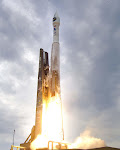Remember....
Be safe--Never use your full name or share personal information online.
Be respectful--State your opinion without being mean or personal.
Please use proper spelling and punctuation.
Be respectful--State your opinion without being mean or personal.
Please use proper spelling and punctuation.
Tuesday, November 23, 2010
August 28,2011 Welcome Back
Welcome back for the new school year. It should be a fun and interesting one. Check below for the general outline of topics covered during the school year for 4th and 5th graders. Please take advantage of the resources located on this webpage.
Tuesday, January 19, 2010
LCROSS FINDS WATER ON THE MOON
LCROSS Impact Data Indicates Water on Moon
11.13.09
NASA today opened a new chapter in our understanding of the moon. Preliminary data from the Lunar CRater Observation and Sensing Satellite, or LCROSS, indicates that the mission successfully uncovered water during the Oct. 9, 2009 impacts into the permanently shadowed region of Cabeus cater near the moon’s south pole.
The impact created by the LCROSS Centaur upper stage rocket created a two-part plume of material from the bottom of the crater. The first part was a high angle plume of vapor and fine dust and the second a lower angle ejecta curtain of heavier material. This material has not seen sunlight in billions of years.
LCROSS was launched June 18, 2009 as a companion mission to the Lunar Reconnaissance Orbiter, or LRO, from NASA's Kennedy Space Center in Florida. After separating from LRO, the LCROSS spacecraft held onto the spent Centaur upper stage rocket of the launch vehicle, executed a lunar swingby and entered into a series of long looping orbits around the Earth.
What other secrets will the moon reveal? The analysis continues!
11.13.09
NASA today opened a new chapter in our understanding of the moon. Preliminary data from the Lunar CRater Observation and Sensing Satellite, or LCROSS, indicates that the mission successfully uncovered water during the Oct. 9, 2009 impacts into the permanently shadowed region of Cabeus cater near the moon’s south pole.
The impact created by the LCROSS Centaur upper stage rocket created a two-part plume of material from the bottom of the crater. The first part was a high angle plume of vapor and fine dust and the second a lower angle ejecta curtain of heavier material. This material has not seen sunlight in billions of years.
LCROSS was launched June 18, 2009 as a companion mission to the Lunar Reconnaissance Orbiter, or LRO, from NASA's Kennedy Space Center in Florida. After separating from LRO, the LCROSS spacecraft held onto the spent Centaur upper stage rocket of the launch vehicle, executed a lunar swingby and entered into a series of long looping orbits around the Earth.
What other secrets will the moon reveal? The analysis continues!
Tuesday, March 10, 2009
Mr. Adams' Students to Participate in Moon Mission
.jpg)
Mr. Adams has been selected as one of 25 teachers to learn how to operate the Goldstone Apple Valley Radio Telescopes remotely from the classroom. Mr. Adams completed the first phase of his training on February 28th at NASA Ames research Center in Mountain View.
During this training he used the radio telescopes to get measurements from a quasar over 14 billion light years from Earth, tracked and computed the path of the ACE satellite using the Doppler Effect, and measured the temperature of the atmosphere of Jupiter. Completing this training will allow students in the classroom to access several of the Goldstone Apple Valley Radio Telescopes to do ongoing research on Jupiter, Uranus, and a number of distant Quasars. Students will use laptops from the BUSD EETT Grant to control the giant radio telescopes by entering a few numbers and with just the click of a mouse. We will also participate in several upcoming NASA
Missions. The first of these missions, the Lunar LCROSS Probe looking for water on the Moon is scheduled to launch May 24th with an impact on the Moon in late August or early September. Students will be "caretakers" of this probe, making sure that it is "healthy" and "on
course." NASA's budget has NASA Scientists checking on the probe every third day, with students in the classroom responsible to monitor it the other days. For more information about the NASA LCROSS Mission click on the NASA LCROSS line below in the "links to look at" section of this blog. For more information on the Goldstone Apple Valley Radio
Telescopes, click on the Goldstone Apple Valley Radio Telescopes link in the same section below. Future NASA Missions that include our involvement include the Juno Program scheduled for liftoff next year. This mission will study Jupiter, and our students will be doing
part of the research to answer several questions, including "How deep does the layer of Jupiter that has "weather" go? What is the core of Jupiter like? Is it a solid core or not? For LCROSS countdown check the NASA launch "countdown clock" to the right of this window, and go to
the NASA link below for information on future NASA launches.
Subscribe to:
Posts (Atom)
